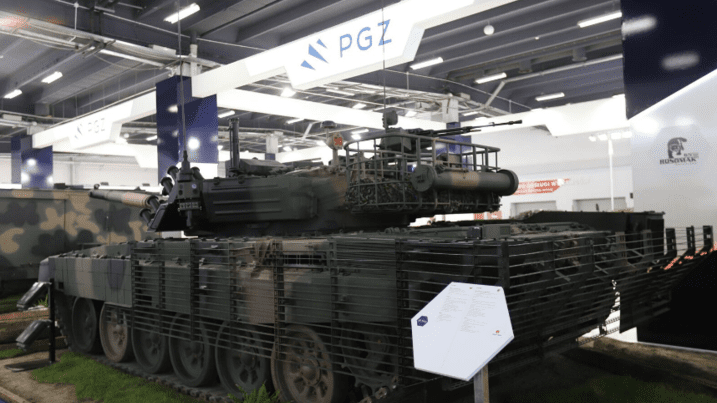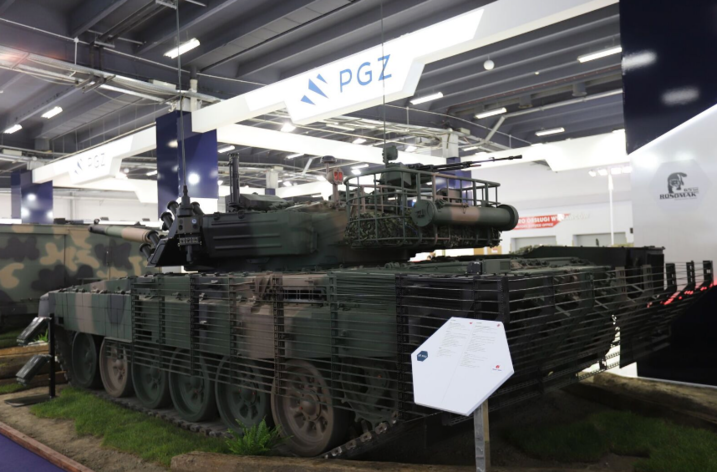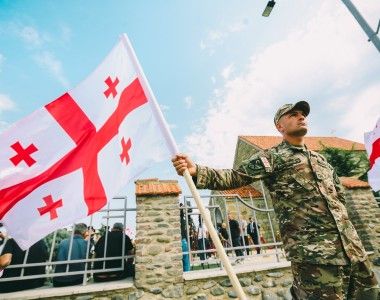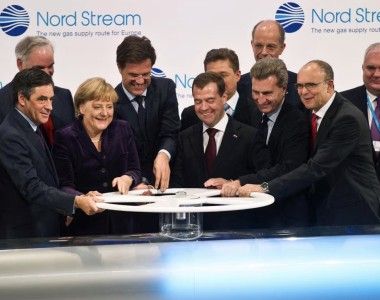Polish Upgrade Programme for the T-72 Main Battle Tank

PGZ Group and ZM Bumar Łabędy S.A. facility (which belongs to the group), as well as other subordinated domestic and foreign entities, have developed a modernization package for the T-72M1 and PT-91 Twardy main battle tanks. The whole upgrade has been created with the requirements defined by the Polish Ministry of Defence in mind. PGZ Group also has a significant potential at its disposal, allowing the entity to modernize other main battle tanks belonging to the T-72 family all around the world.
Within the framework of the Strategic Defence Review, the Polish Ministry of Defence decided to incorporate the upgrade of the T-72M1 tanks in the technical modernization programme pursued by the military. This is to make it possible to maintain the potential within the armoured units, until the expected new generation tank is developed. It is assumed that vehicle as such would be created on the basis of an industrial collaboration.
Back in 2017, the Armament Inspectorate announced that analytical-conceptual phase began, with regards to potential upgrades of the T-72M1 main battle tanks. PGZ is one of the entities that expressed its will to be involved in the market analysis, along with three of its companies: ZM Bumar-Łabędy S.A., WZM S.A. [Military Automotive Works], and OBRUM Gliwice.
However, as of now, the scope of upgrade has not been unanimously defined publicly. We know that the Polish Ministry of Defence would rather be inclined to carry out a shallow, yet cost-effective upgrade. Should such path be taken, the main armament or turret would remain unchanged. PT-91M2 main battle tank was a response to such requirements. The said platform was being showcased by Bumar-Łabędy and PGZ, during the last year’s edition of the MSPO Kielce defence salon. PT-17 tank, presented alongside, is a proposal of an in-depth upgrade of the platform, created with the export markets in mind.

When it comes to enhancing the PT-91M2 tank’s firepower, it was proposed that the 125 mm 2A26M/2A46 cannon is replaced with the Slovak-made 2A45MS model. It is also possible to consider other cannons (e.g. the Ukrainian KBA3 model). In case of in-depth modernizations, it was assumed that the whole turret shall be replaced with a 120 mm KBM-2 smooth-bore cannon (barrel length of 50 calibres).
125 mm 2A46MS cannon has a barrel length of 48 calibres, nonetheless its parameters seem to match the upgrade requirements. As a result of changes related to its design, it offers accuracy which is somewhat improved (4 times), in comparison with the guns used at the moment. The new manufacturing process adopted also extends the gun’s lifetime, in case when sabot rounds are utilized.
KBA-3 cannon based on the 2A46M/M-1/M-4 solution has ballistic performance specification close to the Russian 2A46M-5 gun of the modernized T-72B3 tank, as the Ukrainian designers suggest. The tank gun in question may also be used to launch ATGMs, such as the Kombat missile. Thrust bearing element of the turret is also going to be replaced, with a backlash-free component.
It is also possible to modernize the AZ carousel autoloader (upgrade up to the AZ-1 variant with a digital control system, informing the gunner on the types of ammunition available). The secondary ammunition storage may also be rearranged. The latter step would diminish the risk of the rounds exploding, should the vehicle be hit or exposed to a mine blast.
2E28M electrohydraulic stabilizer may be replaced with an electromechanical digitally controlled EPS-72/91 Albatros solution. Alternatively, modification of the system is also possible through replacement of parts and components and introduction of a digital control block. Nonetheless, an entirely new solution would be advantageous here. ZSMU-1276 remote controlled .50-cal. armament module along with 902A/W smoke grenade launchers can be used as secondary armament. The grenade launchers could utilize GM-81 and GAK-81 grenades delivered by ZMD S.A. and Niewiadów S.A.
In order to enhance the tank’s firepower and crew’s situational awareness, SAVAN-15 FCS or TKN-3Z commander NVG system are proposed to be used, along with a PNK-72 NVG solution for the driver. The tank may also be fitted with the PCO SOD thermal-tele-vision daytime-night-vision 360 Degrees Observation System.
The representatives of the industry also considered other fire control systems dedicated for the T-72M1 platform, including Aselsan Compact Fire Control System (C-FCS), Elbit Systems Knight (with no turret modifications required) or TURMS-T/LOTHAR solution proposed by Leonardo.
III Gen. KLW-1 ASTERIA thermal vision camera operated at wavelengths from 8 to 12 µm and based on a MCT (HgCdTe) sensor is yet another option here. The said camera offers resolution of 640x512 pixels. The design in question is currently replacing the PT-91 tank’s EI-Op TES camera, which is a component of the Drawa-T fire control system.
The ZMKT thermal vision camera modification package does not require any modifications to be implemented, and without any problems it may be installed at the bases of the units operating the Twardy tanks. The Polish military has received at least several upgrade kits like that so far, for the PT-91 tanks.
Development of new generation anti-tank ammunition for the T-72M1 and PT-91 platforms is yet another important issue that needs to be addressed, during the modernization programme. R&D efforts within that scope are already underway, involving MESKO and the Military Institute of Armament Technology in Stalowa Wola.
At the moment, most of the 125 mm sabot rounds remaining in storage date back to the Warsaw Pact era, but the capabilities they offer are inferior even to those ascribable to the rounds used by the Soviet Union back in the 1980s. In fact, one cannot speak of any capability enhancement in case of the T-72M1/PT-91 main battle tanks, should no steps be made to introduce new ammo.
The modernization is also to introduce extra communication and datalink systems. The whole communication suite is to include digital VHF and HF IP radios and new intercoms, with access authorized net-centric operation allowed. Other elements of the upgrade kit include navigation system or GPS receiver (such as the Honeywell TALIN 3000 solution).
When it comes to protection, ERA, composite or combined armour may be applied, depending on the variant. In case of the PT-91M2 tank we are speaking of a new ERA (modified Erawa I/II solution), attached to the front and side surfaces of the turret and the hull, including, in total, 273 elements.
The tank may also receive side and back slat-armour. In case of an in-depth upgrade, composite armour or Ukrainian Zaslon active protection systems could also be installed. However, this would heighten the cost of the whole programme significantly.
Obra-3 laser warning receiver also constitutes an added value in case of the PT-91M platform. The driver may use a new seat, hanged from the top portion of the vehicle. Optionally, the front part of the hull bottom may also be reinforced.
It is also possible to use Deugra fire suppression system utilizing the DeuGen-N agent, offering coverage within the engine, crew and APU compartments. Optionally, Berberys camouflage (radar/IR) delivered by Lubawa S.A. may also be added.
In order to enhance the mobility of the tank, it has been proposed that S-12U engine is used. The unit is derived from the standard W-46-6 solution, and delivers power output of 574 kW. The modernization kit for this engine includes reinforced cylinder sleeves, new exhaust valves, bushings, modified injection and air filter and replaced starter heater (Webasto or Ebersparcher).
The engine offers a power output of 625.5 kW/850 HP at 2000 RPM. As a result, the user gets 13.5 kW per tonne and torque of 3400 Nm at 1300-1400 RPM. Side gearboxes would also be modified, along with the engine upgrades (Cx version). The aforesaid scope of modifications would also require overhaul of the intermediary and planetary gearboxes.
Suspension of the tank is also expected to be reinforced, with new torsion bars (compensation of the heightened weight and enhanced stability) and shock absorbers/elastomer bumper elements to be installed. The torsion bars mounting angle would also be changed.
The Gliwice-based facility also proposed that S-1000R/Renk ESM 350M powerpack is used. Alternatively the Ukrainian 6TD-2 engine could also be applied.
T-72 drivetrain modernization had also been proposed by the WZM-Poznań facility, belonging to the PGZ Group. Two engine modification options have been prepared: S625 (625 kW/850 HP) and S736 (736 kW/1000 HP).
WZM S.A. is a place where Drivetrains Centre is located. The facility in question is to support maintenance, modernization and manufacturing efforts concerning the drivetrains for all of the Polish military vehicles. The maintenance works related to drivetrains, carried out in Poznan, are carried out, for instance, in case of all variants of the Leopard 2 main battle tanks.
PT-91M2 may also receive rubberised tracks and properly modified drive wheels, new steering system and new control panel for the driver with extra portable control panel, KDN-1 reversing camera, or one of the APUs available, for instance the 4.2 kW variant coupled with the AC system featuring a 7 kW compressor.
Furthermore, new electrical system is proposed for the platform and the turret, carried out with the use of Raychem technology. New sliding joint, digital control, power supply and starter blocks, equipment basket at the back of the turret, new external and internal lighting or A/C systems could also be applied.
Rheinmetall, UkrOboronProm, ZTS-ŠPECIĂL, Czechoslovak Group, Renk, Safran Electronics, Aselsan, Elbit, Leonardo, Webasto, Ebersparcher or Kidde were the foreign partners involved in development of the modernization package.
Throughout the recent period, several modernization options regarding the discussed platforms were showcased. To some extent the upgrade packages were using proven solutions. Development of the proposals is also based upon analysis of combat use of main battle tanks in conflicts around the world. The proposed variants include, along the PT-91M2 platform discussed above, PT-91Ex, PT-91IP, PT-72U, PT-91U, or PT-16/17 verion.
In fact, each and every case assumes that firepower and maneuverability of the tank shall be improved, with enhancements also made with regards to protection, comfort or maintenance of the vehicle. The scope of the implemented changes can be determined by the tactical and economic context in which such process takes place. The operational conditions also have a great impact on the shape of potential upgrades.


